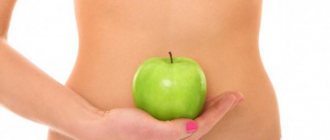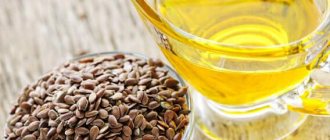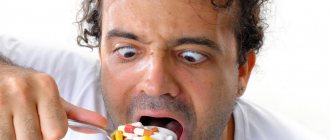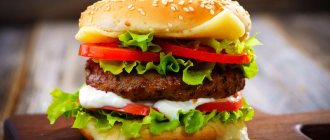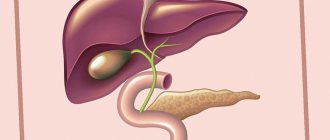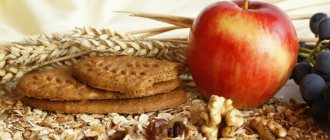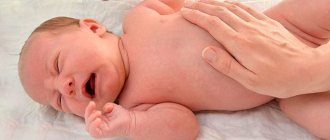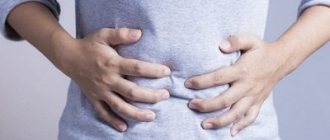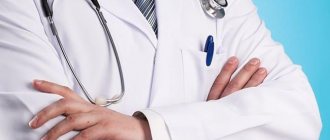Of all the diseases of the gastrointestinal tract, characteristic of both adults and children, dyskinesia of the large intestine is a very common condition. Moreover, this diagnosis is more often given to women rather than men, who are less susceptible to stress.
It is not easy to recognize the pathology on your own, since the symptoms of ailments associated with the gastrointestinal tract are often similar.
Intestinal dyskinesia - what is it?
Doctors also call this condition irritable bowel syndrome or spastic colitis. K59.8.1 – disease code in ICD-10. It is characterized by a whole complex of digestive function disorders, the manifestations of which affect the small (in particular, duodenum) and large intestine. The functionality of the organ mucosa is disrupted, accompanied by severe pain.
The disease is considered quite serious, since even during conscription into the army, a young man suffering from spastic colitis is given the right to choose the type of military service to serve.
Symptoms of intestinal dyskinesia
The clinical picture may include a variety of signs in patients, making diagnosis difficult. Most often, patients are concerned about:
- Abdominal pain.
This symptom is the main one. In many cases, it is not possible to establish the exact localization of unpleasant sensations - their area of distribution is too vast. - Variety of pain patterns.
Patients describe it as paroxysmal or constant (lasting several hours), as dull, aching or sharp, boring. - Absence of painful sensations during a night's rest
, but their return after waking up. - Frequent replacement of long-term constipation with diarrhea
and vice versa. - The presence of mucus
in the stool. - Bloating
, flatulence, rumbling. - The appearance of pain immediately after finishing eating
or due to stress. - Discomfort in the heart
or back area. - Increased irritability
. - Depression
, sleep disturbances.
Intestinal dyskinesia
Hospitalization to the gastroenterology department is required only for initial treatment (for a complete examination and diagnosis) and difficulties in selecting therapeutic measures. In the vast majority of cases, treatment is carried out on an outpatient basis. The main goal of therapy is to eliminate the symptoms of the disease and restore social activity.
Non-drug treatment may require the participation of a psychologist to relieve anxiety and convey to the patient the essence of his disease. It should be explained to the patient in an accessible form that this disease does not pose a threat to his life and is of a functional nature. It is necessary to focus on normal examination results and the absence of serious organic pathology. Together with a nutritionist, foods whose consumption leads to an exacerbation of symptoms are identified, and an individual diet is developed.
Drug therapy depends on the form of dyskinesia. When constipation predominates, various laxatives are used (increasing the volume of feces, stimulating intestinal motility, osmotic laxatives). Osmotic laxatives and drugs that increase the volume of feces do not affect the intestinal wall and intestinal motility and can be used for a long time. Motor stimulants are usually used in cases where the first two groups have been ineffective; are prescribed in a course of no more than 10 days. It is preferable to simultaneously use drugs with two different mechanisms of action.
If diarrhea predominates in the clinic, loperamide and dioctahedral smectite are prescribed - their effectiveness has been clinically proven. Many authors discuss the advisability of prescribing probiotics. Currently, it is believed that probiotics containing bifidobacteria are the most effective. The mechanism of their action is to normalize the ratio of pro-inflammatory and anti-inflammatory mechanisms in the intestinal wall, which leads to the mitigation and even disappearance of the symptoms of the disease. Antibacterial therapy is carried out according to strict indications.
In the mixed form of the disease, constipation alternates with diarrhea; patients most often complain of abdominal pain and increased gas production. In this case, anticholinergic drugs and antispasmodics have the greatest clinical effect. If necessary, a psychiatrist is consulted and antidepressants or antipsychotics are prescribed to relieve anxiety and reduce the intensity of pain.
Types of disease
Large intestinal dyskinesia is diagnosed in two types:
- Independent - primary spastic colitis - appears due to a disorder of intestinal motility.
- A disease that develops due to disruption of the functioning of other organs of the gastrointestinal tract or changes in hormonal levels is secondary colitis.
Hypermotor spastic dyskinesia
It is characterized by increased intestinal tone, which is accompanied by spasmodic contractions. The patient complains of loose stools, aggravated by colic, cramping and paroxysmal pain. There is a feeling of fullness in the intestines, gases collect in the stomach, and belching appears.
Hypomotor atonic dyskinesia
The disease is accompanied by a decrease in the motor function of the intestinal muscles and constant constipation. The accumulation of compacted feces causes bursting pain in the lower abdomen. Against this background, the patient’s well-being deteriorates. Appears:
- weakness;
- nausea;
- rectal polyps;
- haemorrhoids;
- anal fissures.
The patient becomes irritable with sudden mood swings.
Biliary dyskinesia: what is hidden behind this diagnosis?
Abdominal pain, nausea, constipation are the most common symptoms of biliary dyskinesia. We asked Yulia Anatolyevna Saltymakova, a gastroenterologist at the Expert Clinic Tula, to tell us why this disorder occurs and how it can be overcome.
— Yulia Anatolyevna, what is biliary dyskinesia?
— This is a disruption of the functioning of the entire biliary system, and especially the gallbladder. This refers to both hypermotor disorders, i.e. excessive contraction of the gallbladder, and hypomotor disorders - insufficient (weak) contractility of the organ. This disease occurs in both adults and children.
— What are the causes of biliary dyskinesia?
- There are many reasons. The most common is, of course, a nutritional disorder. If we talk about small children (I mean up to three years old), then it can be difficult to feed them. Therefore, quite often parents and grandparents begin to act on the principle: let him eat at least something. And this, as a rule, is something sweet and tasty, that is, fast carbohydrates: juices, buns, sweets, pancakes or sausages. Children love these foods; they are easy to feed. But, unfortunately, this almost always leads to very unfavorable consequences.
If you take older children, their diet often changes when school, sections, and clubs appear. Between extracurricular activities and school, the child may have a quick dry snack and comes home late. And it turns out that he can eat a full meal only after 7 pm. Naturally, his hunger increases during the day, and heavy late meals have a very negative impact, primarily on the functioning of the gallbladder.
It's the same for adults. They say: “We are so busy that we can’t eat properly, so we eat twice a day – at lunch and then at night.” This is where the problems begin.
In addition, the nervous system is closely related to the digestive system. Increased emotional overload, some stressful situations in the family, school - all this negatively affects the functioning of the entire digestive system, and the gallbladder is most susceptible to such factors.
Its functioning is also strongly influenced by the functioning of the intestines. Sometimes constipation and infrequent bowel movements (once every two to three days) can affect the functioning of the gallbladder and cause biliary dyskinesia.
In children, almost all gallbladder diseases (in 99% of cases) are secondary. That is, they are associated, for example, with inflammation in the small intestine, more often in the duodenum. Reactive changes in the pancreas always affect the functioning of the gallbladder, due to the anatomical proximity of their ducts. Therefore, the doctor always strives to get to the bottom of the true cause of the dysfunction of the biliary tract.
The diagnosis of “biliary dyskinesia” may hide diseases of other organs, not just the gallbladder. Therefore, the diagnosis of abdominal pain often requires an extensive examination, which does not always cause understanding on the part of parents.
Read materials on the topic:
Is there a stress vaccine? Congestion again! What to do if your child is constipated? Constipation in adults: looking for causes and getting rid of it Pancreas: the one and only. How to keep her healthy?
— How does biliary dyskinesia manifest in children and adults?
— The main symptom in both children and adults is abdominal pain. Preschool children, if you ask them where it hurts, most often point to the navel, i.e., the peri-umbilical area. But a further examination of the child is required to determine whether the pain is really in the umbilical area or somewhere else. Because sometimes kidney diseases can manifest themselves as abdominal pain. It is better to contact a specialist, for example, a gastroenterologist.
In 80% of children, gallbladder dyskinesia occurs of the hypomotor type. Clinically, it is possible to distinguish between types of dyskinesias. Spastic, stabbing pain is more characteristic of hypertonicity of the gallbladder or sphincter of Oddi (a muscular valve located in the duodenal papilla of the duodenum). Aching, almost constant pain that occurs an hour after eating is characteristic of hypotension of the biliary tract.
In addition to pain, there is often nausea, irregular or loose stools, and changes in appetite (there may be either increased or decreased appetite).
Read materials on the topic:
Mom, my stomach hurts! What is hidden behind a child’s abdominal pain? An insidious pain-mask. Does abdominal pain always indicate problems with the gastrointestinal tract?
— What could be the consequences if you ignore the symptoms of the disease?
— Let’s say the patient has insufficient (weak) contractility of the gallbladder. Accordingly, the separation of bile from the biliary tract will be impaired. That is, a certain stagnation of bile will form. When performing an ultrasound of the abdominal organs, we see that sediment or sometimes even sand appears in the gallbladder. This can lead to the development of chronic inflammation in the gallbladder itself or even the formation of stones. Sand, dense sediment is already the primary stage of cholelithiasis.
90% of chronic diseases in adults begin in childhood. The gallbladder is a “silent” organ, and in children it hurts extremely rarely. Ignoring any changes in the ultrasound of the abdominal organs means providing the child with chronic diseases of the digestive system in the future.
— What studies are prescribed to diagnose “biliary dyskinesia”?
— First of all, ultrasound of the abdominal organs. The function of the gallbladder can only be checked by cholecystography. The most affordable option is an ultrasound of the gallbladder with a test breakfast. In this case, an ultrasound of the gallbladder is done three times, and only then can one judge the types of dysfunction of the organ (hyper- or hypodysfunction). Changes in the volume of the gallbladder, its size, deformation (constrictions, kinks) and even sand, sludge syndrome (sediment in the gallbladder formed due to stagnation of bile) appear when there is a violation of the outflow of bile or liver diseases.
A general blood and urine test and coprogram are also prescribed. A coprogram is a stool analysis that can be used to judge which organ of the digestive system is most affected: the gallbladder, stomach or pancreas, and whether there are inflammatory changes in the large intestine.
— Yulia Anatolyevna, how is biliary dyskinesia treated?
— Treatment of biliary dyskinesia consists primarily of normalizing the diet. At the appointment, we discuss the diet with the patient in great detail: how often and at what time to eat, what foods are best excluded from the diet. Treatment of dyskinesia begins with the simplest drug therapy. It could be mineral waters or some kind of herbal infusion. Well, and, as a rule, choleretic drugs and enzymes that improve the functioning of the gallbladder, its contractility, and sometimes even improve appetite in children who are difficult to feed.
Of course, the treatment plan is always developed individually, taking into account all the nuances of the disease and contraindications. For example, choleretic drugs cannot be used for acute inflammatory changes in the biliary system (including cholecystitis), reactive hepatitis, ulcerative and erosive diseases of the upper digestive tract (esophagus, stomach, duodenum). Therefore, any treatment should be prescribed by a doctor, preferably a gastroenterologist.
— How should you eat if you have biliary dyskinesia?
— The biggest impact on the functioning of the gallbladder is the excess of carbohydrate foods, preservatives, and dyes in our food products. Therefore, we always emphasize that the more natural the food, the better. Chocolate, sweets, juices, and baked goods, which are loved by both small children and teenagers, should be limited. There must be parental control.
You can always find an opportunity to normalize nutrition – both yours and your child’s. If, for example, the children are very busy, you can collect some small plastic containers for school, or take them with you when you take your child to classes or clubs. Everything can be adjusted and the problem can be gradually dealt with.
— How to prevent the development of biliary dyskinesia? Have measures to prevent this pathology been developed?
- Yes. I would like to say that first of all, this is, of course, proper nutrition, but proper sleep and rest are no less important. In some families, depending on the work schedule of their parents, school-aged children start studying late, go to bed late, and get up early for school. And the child’s body does not have time to fully recover. This results in overwork, which also affects the functioning of the digestive system.
Another important point is that you need to move more. Unfortunately, physical inactivity is now a scourge that affects not only adults, but also children. Due to the obsession with cell phones and similar gadgets, there is a lack of movement. Physical inactivity in children entails the appearance of excess weight and, accordingly, disruption of digestion. It is very important to prevent these problems, since some chronic pathologies can develop due to overweight or obesity. Changing eating behavior, for example, in a child aged 12–13 years, when it has already formed, is very difficult. Therefore, it is important to think about such things as early as possible.
Read materials on the topic:
Childhood is for movement! What does physical inactivity lead to? How to make a child become obese?
You can make an appointment with a gastroenterologist here You can make an appointment with a pediatric gastroenterologist here
ATTENTION: services are not available in all cities
Interviewed by Marina Volovik
The editors recommend:
Not always gastroscopy. Examination for abdominal pain Remove or leave? What to do if gallstones are found? Not only a colonoscopy: what will a stool test tell you? How to protect your stomach from ulcers? When your gut rebels: what is irritable bowel syndrome?
For reference:
Saltymakova Yulia Anatolyevna
In 2003 she graduated from the Tver State Medical Academy.
2004 – internship in pediatrics.
2006 – primary specialization in gastroenterology at the Research Institute of Pediatric Gastroenterology, Nizhny Novgorod.
Currently, he is a gastroenterologist at the Expert Clinic in Tula. Receives at the address: st. Boldina, 74.
Causes of the disease
The appearance of primary spastic colitis is often caused by factors of a psychogenic nature:
- Experienced stress.
- Nervous tension, nervousness.
- Long-term depression.
- Negative emotional background around the patient.
The second most common causes of irritable bowel syndrome are those related to diet and diet, in particular, insufficient fiber intake.
In addition, primary dyskinesia develops due to the proliferation of pathogenic flora in the intestines or due to food poisoning.
Secondary colitis is provoked by:
- Diseases of the abdominal organs.
- Hormonal imbalances.
- Diabetes.
- Uncontrolled use of antibiotic drugs, psychotropic substances and anticonvulsants.
Causes of intestinal dyskinesia
Dyskinesia can develop independently or against the background of other diseases of the gastrointestinal tract. Depending on this parameter, the disease is classified into primary and secondary.
Secondary dyskinesias may be associated with the following diseases:
- cholecystitis;
- peptic ulcer of the stomach, duodenum;
- bacterial and viral intestinal infections;
- endocrine diseases (diabetes mellitus, hypothyroidism, etc.).
If the digestive system is healthy, other factors may be the cause of dyskinesia: taking certain medications (antibiotics, psychotropic drugs, contraceptives, etc.), improper (unbalanced) nutrition, allergic reactions, inflammatory diseases of other organs and systems, excess weight.
Accurate diagnosis
If a patient has symptoms of intestinal dyskinesia, you need to seek help from a gastroenterologist, who will prescribe the necessary examinations and tests, study the symptoms, and then make a diagnosis.
Since the clinical picture of intestinal dyskinesia is similar to other diseases, diagnosis is carried out by exclusion:
- At the first stage, the large intestine is examined for the presence of life-threatening pathological processes and formations (polyps, tumors, diverticula).
- Then a stool analysis is prescribed to identify blood or mucus impurities, as well as endoscopy and irrigoscopy.
If indicated, a biopsy of the affected tissue may be necessary.
Symptoms and manifestations
Manifestations of intestinal dyskinesia depend on the form of the disease: spastic is characterized by colic and diarrhea, atonic is characterized by impaired peristalsis and constipation (including the discharge of large amounts of mucus). Common symptoms include the following:
- bloating, especially in the evening;
- pain (dull or aching, cutting, spasmodic), heaviness in the abdomen, discomfort;
- belching;
- nausea.
Typically, unpleasant symptoms intensify after eating and subside immediately after bowel movement.
The consequences of the disease also depend on its form. As a result of prolonged bowel dysfunction, dehydration or intoxication, anal fissures, and exacerbation of hemorrhoids may occur. With prolonged intoxication with feces, general health worsens, appetite decreases, dizziness and skin rashes appear.
Treatment of dyskinesia
For recovery in a short time, gastroenterologists recommend treating adult patients using an integrated approach. This is a combination of drug therapy methods and traditional medicine recipes.
In addition, it is important to review the diet of a person suffering from spastic colitis. The diet should include foods enriched with vitamins, minerals and fiber. A sufficient amount of fresh fruits and vegetables will reduce the risk of relapse of the disease.
Attention should also be paid to timely bowel movements. In a healthy person, defecation occurs once a day at approximately the same time.
Medicines
The therapeutic method of combating dyskinesia directly depends on its type:
- Hypermotor colitis precludes the use of laxative medications. Gastroenterologists prescribe antispasmodics to alleviate the condition (No-spa is taken 1-2 tablets three times a day).
- Hypomotor dyskinesia should be treated with the use of enzymes and choleretic drugs.
To put the nervous system in order, antipsychotics and antidepressants are prescribed.
Folk remedies
Alternative medicine should not replace the main course of treatment. Its task is to complement and enhance the effect of drug therapy. In addition, there are cases when not all medications can be taken. For example, pregnancy or individual intolerance to components.
Tincture for dyskinesia
Take 2 tablespoons of a mixture of yarrow, St. John's wort flowers, motherwort herb, sage, oak bark. Pour 250 ml of boiling water and leave for two hours. Then strain the healing infusion through a bandage or gauze.
Therapeutic diet
Patients suffering from intestinal dyskinesia should control their diet and take into account the following recommendations:
- Consume fresh, natural products (without dyes, preservatives, or flavor enhancers).
- Most of the diet is porridge (wheat, millet, buckwheat, oatmeal). The restriction applies only to rice cereals.
- Increase the consumption of fruits, vegetables, freshly squeezed juices (cabbage, beetroot, carrot, apple).
- Drink at least 2 liters of clean water per day.
- Process foods by boiling, baking or steaming.
- Avoid eating fatty meats and fish.
- Eat only fresh fermented milk products, otherwise the effect will be the opposite - constipation is possible.
- Reduce the amount of salt in prepared dishes.
- Eliminate pastries and sweets.
Portions should be small, and the number of meals per day should be 5–6 times. It is strictly not recommended to overeat.
A special diet is a prerequisite for the effectiveness of treatment of any disease associated with the digestive system. In this way, it is possible to achieve improved intestinal motility, reduce the likelihood of fecal accumulation, and prevent constipation.
Possible complications
Dyskinesia becomes aggravated by exacerbation of the conditions that provoked its appearance:
- cholecystitis;
- cholelithiasis;
- gastritis;
- pancreatitis.
Spastic colitis affects the patient’s usual lifestyle, reducing his social activity. A person withdraws into himself, becomes susceptible to apathetic moods and depression.
It is extremely rare to achieve full recovery. In most patients, symptoms persist all the time and worsen if preventive measures are not followed.
Prevention
To prevent the occurrence of intestinal dyskinesia, gastroenterologists recommend adhering to the following simple rules:
- Lead a healthy active lifestyle.
- Give preference to a balanced, nutritious diet.
- Try to avoid stress or learn to perceive it with restraint.
Spastic colitis is dangerous due to the development of characteristic complications, so timely consultation with a doctor at the first signs of the disease will help to quickly normalize the functioning of the gastrointestinal tract.
An annual preventive examination will allow you to identify pathology in time and prevent its development.
Biliary dyskinesia
Among the many causes of abdominal pain, dyskinetic biliary tract disorders (BBD) stand out. This is one of the most popular diagnoses among therapists in clinics - and at the same time, many cases of ADHD remain undiagnosed. What is the difficulty and how to make a diagnosis?
Bile activity: norm and disorders
Bile (a thick, bitter liquid produced by liver cells) is actually one of our digestive juices. It takes part in the intestinal phase of digestion, helping to break down fats.
In addition, it inactivates pepsin, “brought” by semi-digested food from the stomach, otherwise it reduces the activity of pancreatic enzymes necessary for further digestion. Produced in the liver, bile enters the gallbladder through the hepatic duct system - there it accumulates and “ripens”, becoming more concentrated.
Read also: Diet for gallstone disease
As soon as a portion of food from the stomach enters the duodenum, cystic bile is “added” to it through the common bile duct. The hepatic bile ducts, gallbladder, common bile duct and the circular sphincter muscles that separate them together make up the bile ducts.
When the coordinated work of these structures is disrupted, a condition called dyskinesia occurs (“dis” - disorder, “kinesio” - movement). Today, there are two main variants of JVP.
Hyperkinetic variant: stress and acute pain
With hyperkinetic GIB, bile, especially not remaining in the bladder, enters the intestine at an accelerated pace, and not on “demand”. In this case, firstly, the efficiency of digestion decreases, since immature bile that has not settled in the gallbladder has low chemical activity. Secondly, there is an increased and almost continuous contraction of the muscles of the ductal system.
Disorders in the movement of bile are usually provoked by fatty foods and - this is important! - stress. The muscles of the biliary tract are controlled by the autonomic nervous system. When its sympathetic (adrenaline, “stress”) part is activated, muscle contractions intensify and accelerate.
The patient experiences sharp stabbing pain in the right hypochondrium. Inadequate digestion leads to stool disturbances and lack of nutrients. However, the general condition deteriorates little, the patients do not lose their ability to work and vital activity and are not very inclined to a thoughtful diagnostic search.
Hypokinetic option: immobility and long-term pain
Here everything is exactly the opposite: bile is released slowly, remains in the gallbladder for a long time, and its concentration increases more than necessary. The bile ducts seem to be “lazy” to deliver bile to the intestines. Actually, one of the main reasons for this type of ADHD is a sedentary lifestyle.
The pain syndrome with this option looks different: the pain is dull, aching, “spread out” - that is, it can spread throughout the entire abdomen. In some cases, there may be no actual pain, but discomfort is manifested by a feeling of fullness, distension in the right hypochondrium.
The duration of unpleasant sensations reaches several hours (whereas with the hyperkinetic version - usually no more than half an hour). Here, patients are already seriously thinking about solving the problem and finally decide to visit a doctor to get a diagnosis.
How to make a diagnosis
It must be said that with moderately severe JVP, the clinic—that is, the patient’s complaints—is not very specific. Pain and heaviness in the abdomen, transient stool disorders can accompany many other diseases, not always even related to the gastrointestinal tract! However, to confirm the diagnosis in this case, there is an available technique - ultrasound with functional tests.
One of the most common causes of gallbladder gallstones is a violation of the anatomical structure: a change in the shape of the gallbladder, the presence of septa in it, sometimes even doubling. These changes, which impair the flow of bile, occur in at least 25–30% of people (which is why episodes of pain in the right hypochondrium are familiar to many).
Therefore, signs of VADP can often be detected on an ultrasound by a simple examination, but a special test is needed to study motor skills. First, the gallbladder is measured and examined on an empty stomach, and then the patient is offered a so-called “test breakfast” (usually two raw yolks). After eating breakfast, the bladder is measured again at certain intervals, monitoring the change in its shape and volume.
An x-ray examination is performed in a similar way, but it requires special preparation. Bile needs contrast, so first the patient takes special tablets (or receives an intravenous injection). But the probe method is practically not used today - it is very uncomfortable for the patient.
***
What can you do to avoid getting caught by doctors for all this complicated diagnostics? Methods for preventing ADHD are quite simple. You need regular physical activity, a healthy diet, a proper daily routine and, of course, you should take care of your nerves to prevent hyperkinetic dyskinesia.
Lidiya Kulikova
Photo istockphoto.com
